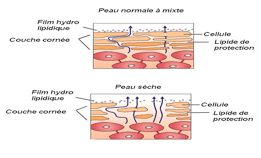
DRY SKIN
Dry skin can be clinically defined as skin that has lost its smooth character to the touch and sight, it has lost its water retention power.
The notion of dry skin is associated with a significant lack of hydration. The most obvious feature is certainly a rough touch and roughness of the skin surface, sometimes accompanied by irregular flaking or cracks that give it a dull and shineless appearance. It can be fragile involving a feeling of discomfort, tend to eczema, be sensitive to cold (tendency to cracking) or dryness of the ambient air resulting in tightness and itching more or less strong. It is also prone to premature skin aging caused by a slowdown in the renewal of epidermal cells.
Lack of sebum : Dry skin has few protective lipids on its surface hydrolipidic film (FHLS) due to sebaceous hyposecretion, so it reacts more strongly to aggressions and its signs of aging (wrinkles, loss of elasticity,...) will be more visible from the renewal of epidermal cells.
Lack of water : There is a decrease in the water concentration of the stratum corneum, due to the alteration of the hydrolipidic film, the decrease in protective intercellular lipids (ceramides) and the slowing down of the synthesis of the components of the natural moisturing factor (NMF = Natural Moisturing Factor) (Figure 1) . These components are urea, uric acid, lactic acid, amino acids, sodium, potassium... located inside the cells of the stratum corneum (corneocytes) and on the surface of the epidermis, this factor has the role of fixing water in these cells.
Dry skin is skin that lacks lipids (sebum), lacks water, or lacks both. Other factors may also be important such as ultraviolet radiation, pollution or climatic conditions.

Figure 1: Alteration of the hydrolipidic film and decrease in protective lipids on dry skin compared to normal to combination skin
Specificity: atopic dermatitis
Changes in lipid composition are directly associated with specific barrier function deficiencies in dry and rough skin.
In atopic dermatitis, the complex pathophysiology of which combines genetic predisposition and environmental factors, disturbances in this lipid structure, such as a reduction in the levels of ceramides and long-chain fatty acids, seem to account for the functional abnormalities observed in dry skin, in particular an alteration in barrier function that leads to an increase in transepidermal water loss, dry skin and promotes the penetration of harmful agents.
One study showed that the skin of patients with atopic dermatitis is colonized by bacteria secreting ceramidase (specific enzyme of the degradation of ceramides); which suggests that the microorganisms found on these skins are related to ceramide deficiency in the stratum corneum of the epidermis. Hypersensitivity is then increased by altering the permeability barrier.
Structural and functional specificities of black and matte skin
Located at the level of the epidermis, the thin upper layer called stratum corneum (SC) provides the barrier function by means of a specific structure, composed of corneocytes and intercellular lipids (ceramides) which ensures the cohesion of these cells thus forming a barrier that minimizes dehydration of the skin.
Black and matte skins are particularly dry because they have difficulty adapting to the temperate climate. Indeed, in France, the air is much less humid than in the intertropical zone.
The stratum corneum must maintain hydration in a given climate, but if it does not capture enough water due to lack of ambient humidity, it slows down its flaking, retaining a significant layer of dead cells, which explains the dull appearance of black skin and its rough touch with visible scales.
Strength of the skin barrier
In black and matte skin the skin barrier is higher with stronger cell cohesion and a higher amount of proteins that are covalently bound, resulting in improved stiffness of the corneal envelope.
Low serine protease activity
The activity of this enzyme responsible for the flaking process is lower so it is slower and results in rough and thick skin.
Low ceramide levels
The composition of the lipid matrix involves three predominant classes of biomolecules: ceramides (45-50%), cholesterol (25%) and fatty acids (11%).
Ceramides are extremely hydrophobic, in comparison with other membrane lipids. This hydrophobia explains their abundance in the stratum corneum, they ensure the cohesion of corneocytes forming a barrier that minimizes dehydration of the skin.
By inhibiting the action of free radicals, elastase, collagenase and slowing down the degradation of structural proteins, they help repair, improve and restructure the texture of the skin.
The small amount of ceramides leads to a defective barrier function and impaired water holding capacity.
This weakness is due in particular to the increase in ceramidase (enzyme specific to the degradation of ceramides).
Conclusion
The combination of strong cell cohesion, reduced serine protease and low ceramide levels makes black and matte skin, extremely dry and visually scaly skin that must be particularly moisturized.
Hydration of black and matte skin
To accomplish its mission of protection, the skin must be a resistant and impermeable barrier. This role largely belongs to the epidermis, directly exposed to the external environment but it is not an impassable barrier, free water from the dermis continuously crosses the epidermis by capillarity and evaporates on the surface of the skin, it is the insensitive loss of water (PIE).
In the opposite direction, the skin can let in water but also active molecules. This skin absorption property is used to moisturize the skin and promote the action of cosmetics.
Before starting hydration with a product suitable for the face such as My Mel'OYA Moisturizing Unifying Care or for the body such as My MEL'OYA Lite Moisturizing Unifying Body Milk, it is necessary to proceed to an exfoliation phase to remove the dead cells of the thick stratum corneum of the black skin, as for example with My Clean'OYA Cleansing Cleansing Cleansing Gel®®® EXTRA.
Hydration will be done through:
- An action on aquaporins (water channels of cells) managing cell permeability in water
- Restoration of epidermal lipids through the use of vegetable ceramides, oils enriched with linoleic or linolenic acids (Desert date oil, Moringa oil,...) and butters (Shea).
- Stimulation of the synthesis of glycosaminoglycans (GAG) main constituent elements of the fundamental substance of the dermis and a strengthening of natural hydration factors (incorporation of humectant such as glycerin or xylitol)
- An integration of sun filter protecting AGAINST UVA and UVB because exposure to the sun without protection causes water to evaporate from the skin





